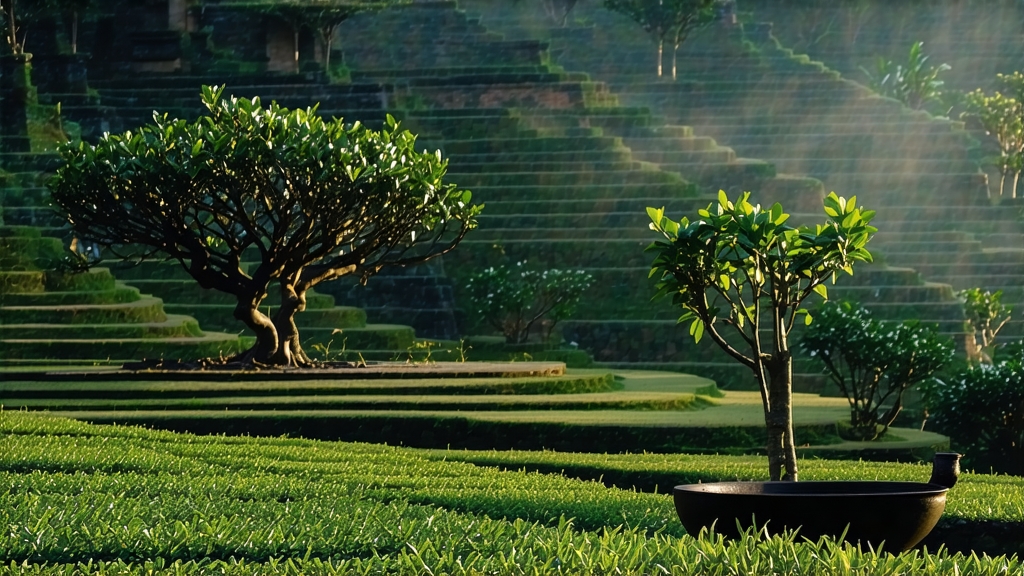
Among the kaleidoscope of Chinese oolongs, Phoenix Dancong stands out as perhaps the most perfumed, complex and story-rich sub-family. Hailing from the Phoenix (Fenghuang) Mountains of Guangdong Province, these leaves are not a single cultivar but a living library of over eighty aromatic “fragrance types,” each traceable to a single, centuries-old tree. To understand Dancong is to listen to a dialogue between geology, genealogy and human artistry that began during the Song Dynasty, flourished under Ming tribute-tea edicts and still evolves in the hands of today’s tea masters.
Historical roots and terroir
Local chronicles record that Song-era villagers discovered wild tea trees growing on the steep, mineral-rich slopes of Wuzhishan and Wudongshan. By the 14th century the imperial court had designated the finest groves as tribute gardens. The mountains’ 600–1 400 m elevation, diurnal temperature swings and well-drained granitic soils force slow growth, concentrating aromatic precursors. Frequent mountain mists filter sunlight, encouraging the synthesis of linalool and geraniol, the same volatile compounds found in orchids and stone fruits. Thus Phoenix Dancong is literally geology translated into fragrance.
From single bush to fragrance type
Unlike plantation teas, Dancong is propagated by seed, creating a genetically diverse forest. When a particular old tree yields liquor with an unmistakable scent—say, fresh ginger flower, almond blossom or ripe mango—growers take cuttings, graft and plant them on nearby terraces. Over centuries this practice produced famous “fragrance types” such as Huangzhi Xiang (orange blossom), Zhilan Xiang (orchid), Yashi Xiang (duck-shit aroma—an insider joke to deter thieves), and the legendary Song Zhong, descended from a 900-year-old mother tree. Each type is still harvested separately, preserving micro-regional identity.
Plucking and withering
The spring harvest begins at dawn when two leaves and a bud are still cool and taut. Leaves are spread on bamboo trays set on mountain ledges where they inhale the rising valley humidity. Every twenty minutes the tea maker gently tosses the leaves, bruising edges just enough to trigger enzymatic oxidation. This “alive” stage lasts from dusk to midnight; the master listens for the whisper of changing aroma, feeling the leaves shift from grassy to floral. When the edges redden to 30 % oxidation—less than Minbei rock oolong but more than Tieguanyin—fixation is triggered with a 260 °C wok roast lasting less than three minutes.
Rolling, shaping and the fire within
While still warm, the leaves are wrapped in thick cotton cloth and rolled into tight, ribbon-like strips. A series of low-temperature charcoal bakes follows, each lasting two to three hours and separated by days of rest. Traditionally the fuel is longan or lychee wood, whose mild smoke imbues a subtle honey note. The baker must “cook the water but keep the fragrance,” reducing moisture to 4 % while locking in volatile aromatics. Some reserve lots receive an additional “second fire” months later, deepening ripeness and adding a cooling mineral finish reminiscent of wet stone.
Tasting architecture
A well-crafted Phoenix Dancong presents a three-act structure. The dry leaf smells of dried apricot and toasted almond. Upon the first flash infusion the gaiwan lid exudes a rush of tropical flowers—gardenia, frangipani, sometimes a hint of passionfruit. The liquor is bright amber, almost copper, with a silky body that carries a sweet-acid tension like mandarin peel. The middle steeps reveal a rocky minerality, a nod to the granitic subsoil, while the aftertaste returns as a cooling menthol sensation known locally as “mountain charm.” Ten infusions in, the tea still hums, softer now, like distant temple bells.
Brewing protocol for the international table
Water: spring or low-TDS filtered, 95 °C.
Utensil: 120 ml gaiwan or 180 ml Yixing teapot previously seasoned with light oolongs.
Leaf ratio: 5 g for gaiwan, 7 g for pot.
Rinse: 5-second pour to awaken the leaves, discard.
First four steeps: 10, 15, 20, 25 seconds, pouring in a thin stream to aer